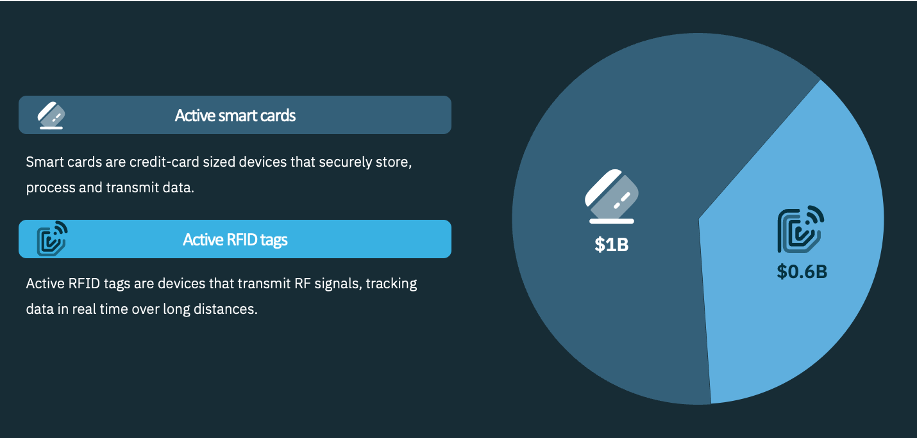The future of IoT
As wireless IoT technology becomes increasingly integrated into everyday life, the demand for high-performance batteries continues to grow. In particular, smart cards and radiofrequency identification (RFID) tags require compact, long-lasting, and high-power energy sources to function reliably. These devices are essential for securing transactions, protecting sensitive data, and enabling real-time tracking across industries like finance, transportation, and global logistics. Smart cards are credit card-sized devices designed to securely store and process sensitive data, often used for authentication, payments, and secure access. Active RFID tags, equipped with their own power source, continuously transmit radio signals, allowing for long-range real-time tracking of assets, vehicles, or personnel, essential in logistics, supply chain management, and security applications.

The growing adoption of these devices is driving the demand for advanced battery solutions. The global market for smart card batteries is expected to reach $1 billion by 2030, driven by a compound annual growth rate of 70%. Similarly, the RFID battery market is projected to grow at 50% annually, reaching $600 million by 2030.
Smart cards and RFID tags are key to building secure, connected systems, yet one major hurdle is holding them back.
The power challenge in IoT
Despite the growing demand for smarter, more capable devices, today’s battery technology is limiting what’s possible. Traditional batteries often take up too much space, limiting miniaturization and design flexibility. This is especially problematic in applications like smart cards, which are expected to maintain the familiar dimensions of a standard credit card. To accommodate the battery, many cards end up two to three times thicker than the standard format. RFID tags face similar challenges. Many applications call for thin, flexible labels that can be easily attached to products, pallets, or equipment. However, conventional batteries are often too rigid and thick, limiting where RFID tags can be attached.
Beyond size constraints, traditional batteries struggle to deliver the sharp power spikes needed for wireless communication. To compensate, devices often require extra components like supercapacitors. Additionally, these devices struggle in extreme temperatures, with batteries exploding in high heat and failing in freezing conditions. This poses a significant challenge in industries like steel production, chemical processing, and cold-chain logistics, where reliability is critical. Other safety concerns with lithium-ion batteries include the risk of leakage, which can expose users and the environment to hazardous chemical solvents.
Moreover, integrating batteries into devices is both complicated and costly. Many conventional options drain quickly or cannot be recharged, leading to frequent replacements that drive up costs and contribute to electronic waste.

These technical shortcomings have long hindered innovation in smart card and RFID technology. Manufacturers are eager to integrate advanced features into miniaturized smart cards and active RFID tags, but current battery technology is holding them back.
For smart cards, high-power output is crucial for enabling a range of next-generation functionalities. These include biometric authentication such as fingerprint, retina, or facial recognition, dynamic security features such as one-time passcodes, CVV and advanced encryption. Additionally, instant user feedback through haptic, visual, or audio alerts and real-time e-ink displays remain out of reach in card format.
RFID applications need rechargeable and long-lasting batteries to significantly extend the lifespan of tags and make them more cost-effective and environmentally friendly. Stability across extreme temperatures would allow RFID-based environmental sensors to function reliably in harsh conditions. Higher power output would unlock real-time tracking and secure, continuous data transmission with encryption over distances of hundreds of meters in a compact and flexible tag.
Industry leaders have already recognized the urgent need for a new approach to battery technology. Charles Bourbonnais, CEO of Hivezox, stated:
“The only thing holding back the widespread adoption of such a solution in a card format is the battery.”
Despite the demand for these innovations, battery technology has yet to catch up, leaving manufacturers with untapped potential.
Unlocking the next generation of IoT
A new generation of all-solid-state batteries offers a breakthrough solution – ultra-thin, high-power, and stable across extreme temperatures – enabling a new generation of more reliable and efficient IoT devices.
This technology directly addresses the pain points faced by manufacturers of smart cards and active RFID tags. Its compact form factor enables smart cards to achieve the thinness of a credit card, while allowing RFID tags to be smaller, customizable, and flexible. Offering five times the power performance of most traditional batteries, it eliminates the need for separate batteries and capacitors, making devices even more compact and efficient. Furthermore, this all-solid-state solution is ideal for applications that demand durability and safety. It is non-flammable and can operate in a wide temperature range up to 150°C, while the solvent-free dry-film technology ensures there are no risks of leakage. The seamless integration of these batteries into devices simplifies the production process, removing complicated steps and making it easier to implement.
BTRY’s first product aims to deliver on all these promises. The envisioned BTRY 1S4P is specifically designed for IoT applications such as smart cards and RFID tags. It could offer a capacity of up to 50 mAh, nominal voltage of 3 V, peak power of 500 mA, and ultra-thin dimensions of 50 x 40 x 0.1 mm, making it the thinnest commercially available battery today, as thin as a hair. Additionally, the battery is intended to feature ultra-fast charging with a target cycle life of over 1000 (at 100% depth of discharge).
Beyond this product, BTRY offers fully customizable batteries that can be tailored in both specifications and form factors. They can be bent and even rolled into cylinders, offering unparalleled design flexibility. Even when cut in half, each piece continues to function as a smaller battery.
For manufacturers and developers looking to stay ahead of the curve, now is the time to explore how BTRY’s innovative battery technology can redefine the future of smart cards and RFID systems.
Interested in upgrading your smart card or RFID battery technology? Start the conversation that will energize your technology and contact us today!



